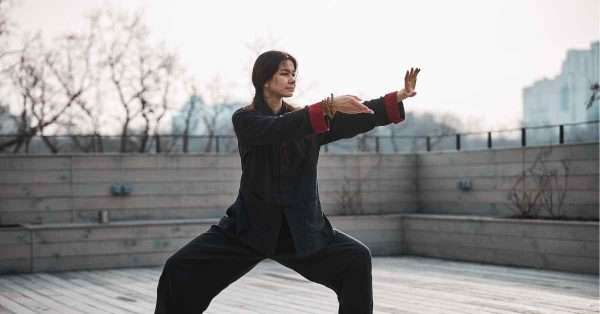Tai Chi, an art form born in ancient China, has evolved from martial combat to a therapeutic exercise. Intertwining movement with mindfulness offers a holistic approach to pain management, emphasizing the interconnectedness of mind, body, and spirit. By the end of this guide, you’ll understand the power of Tai Chi for pain relief!
Historical Roots of Tai Chi:
Tai Chi, which translates to “supreme ultimate boxing,” began as a martial art emerging from ancient China. Deeply rooted in Taoism and traditional Chinese medicine, it embodies the principle of yin and yang – the harmonious balance of opposing forces. Historically, monks practiced Tai Chi to defend their monasteries and cultivate inner peace.
The Philosophy Behind Tai Chi:

- Qi (Chi): At the heart of Tai Chi is ‘Qi,’ the life force or energy flow. Practitioners believe that blockages in Qi lead to health issues. Tai Chi practices aim to cultivate and balance Qi, promoting health and vitality. For instance, the “Wave Hands like Clouds” movement is believed to balance the Qi flowing through the spleen and stomach.
- Yin and Yang: Representing opposing yet complementary forces, Tai Chi movements often reflect this duality. A single routine might combine the softness of a flowing river with the strength of a gusting wind.
Scientific Basis of Tai Chi for Pain Management:
- Mind-Body Synergy:
Tai Chi’s meditative component can divert attention from pain. For example, the “Grasping the Sparrow’s Tail” sequence requires such focus that practitioners often report forgetting their pain. - Improved Mobility:
Movements like “Golden Rooster Stands on One Leg” enhance joint flexibility, aiding those with arthritis or musculoskeletal pain. - Strengthening and Balance:
“White Crane Spreads Its Wings” is a posture that bolsters core muscles improves posture, and enhances balance, which is crucial for fall prevention.
Types of Pain Addressed by Tai Chi:
- Arthritis: The “Brush Knee and Push” movement increases joint flexibility and reduces stiffness.
- Back Pain: “Bend the Bow to Shoot the Tiger” strengthens core muscles, promoting spinal health.
- Headaches: The relaxation techniques in “Repulse the Monkey” can alleviate tension-related headaches.
- Neuropathic Pain: The mind-body focus of sequences like “Fair Lady Works the Shuttles” can help manage neuropathic symptoms.
Different Styles of Tai Chi:

- Chen: Known for its silk reeling, it combines fast and slow movements. The “Cannon Fist” is a distinctive Chen movement.
- Yang: With its slow, steady movements like “Single Whip,” it’s the most widely practiced style globally.
- Wu: Emphasizing micro-movements, it’s gentler on the body. “Step Up to Seven Stars” is a notable Wu movement.
Incorporating Tai Chi into Daily Life:
- Routine: Even just 15 minutes, a morning routine can set a positive tone for the day. The “Opening Movement” is a great start.
- Environment: Practicing in a park or garden, where you can sync with nature, enhances the experience.
- Integration: Use Tai Chi principles daily. For instance, maintain a straight posture (as in “Standing Like a Tree”) at your desk.
Getting Started:
- Classes: Local community centers often offer classes. Starting with a group can provide motivation and ensure you learn the correct techniques.
- Online Resources: Platforms like YouTube have certified Tai Chi instructors offering beginner to advanced lessons.
· Tai Chi 5 Minutes a Day – Module 01 – easy for beginners
- Description: Simple, Easy beginner Tai Chi. Get these YouTube videos in your inbox and learn more.
- Author: Taiflow
- Views: 13,605,467
- Duration: 11:01
- Description: Welcome to your own exceptional tai chi class. It’s a helpful piece of work that you can do.
- Author: Piedmont Healthcare
- Views: 19,916
- Duration: 36:48
· At home: basic Tai Chi exercises
- Description: Fancy trying your hand at Tai Chi? Here are some basic exercises you can do in the comfort of your own home.
- Author: WokinghamBC
- Views: 186,253
- Duration: 23:50
- Books: “The Harvard Medical School Guide to Tai Chi” is a comprehensive resource for those looking to delve deeper.
· T’ai Chi Classics by Master Liao
- Description: An iconic text that delves into the foundational principles and practices of Tai Chi. This book is considered essential for practitioners of all levels. It is recommended for anyone serious about their Tai Chi journey.
- Link to the book
· Cheng Tzu’s Thirteen Treatises on T’ai Chi Ch’uan by Cheng Man Ch’ing
- Description: A comprehensive guide that offers insights into the thirteen core principles of Tai Chi, providing readers with a deeper understanding of its philosophy and techniques.
- Link to the book
· The Dao of Taijiquan: Way to Rejuvenation by Tsung Hwa Jou
- Description: This book delves into the Daoist philosophy behind Tai Chi and offers guidance on rejuvenating the mind and body through its practice.
- Link to the book
Other facts about tai chi:
- Mental Health Benefits:
Beyond physical pain management, Tai Chi has been shown to positively affect mental health. Regular practice can reduce symptoms of anxiety, depression, and stress. The meditative qualities of Tai Chi, combined with controlled breathing and movement, promotes a sense of calm and well-being. - Cardiovascular Health:
Tai Chi can be beneficial for heart health. It’s linked to lower blood pressure, improved cholesterol levels, and enhanced cardiovascular function. The gentle movements increase heart rate just enough to provide cardiac benefits. - Improved Sleep:
Many practitioners report better sleep quality after incorporating Tai Chi into their routines. The relaxation techniques used in Tai Chi can help alleviate insomnia and promote more profound, more restful sleep. - Enhanced Immunity:
Some studies suggest that Tai Chi can boost the immune system, making practitioners less susceptible to illnesses, including the common cold or flu. - Better Respiratory Function:
The deep, rhythmic breathing techniques used in Tai Chi can improve lung capacity and function. This can be especially beneficial for those with respiratory conditions like asthma. - Bone Health:
Regular Tai Chi practice can benefit bone density, making it a recommended exercise for post-menopausal women at risk of osteoporosis. - Digestive Health:
The movements in Tai Chi can stimulate the abdominal organs, leading to better digestion and alleviating digestive disorders. - Cognitive Benefits:
Tai Chi isn’t just about moving the body; it’s also about focusing the mind. This dual action can enhance cognitive functions, improve memory attention, and even reduce the risk of cognitive decline in older adults. - Social Interaction:
Joining a Tai Chi class can provide a sense of community. Practicing in groups can foster social interaction, reducing feelings of loneliness and isolation. - Cultural Appreciation:
Delving deep into Tai Chi offers a window into Chinese culture, philosophy, and history. It’s an exercise and a cultural treasure trove that provides insights into ancient Chinese wisdom. - Adaptability:
One of the beauties of Tai Chi is its adaptability. It can be practiced by people of all ages and physical abilities. There are even seated versions of Tai Chi for those who might have mobility issues or are wheelchair-bound.
Safety Precautions:
- Consultation: If you have health issues, always consult a healthcare provider before starting.
- Listen to Your Body: If “Wave Hands in Clouds” causes discomfort in your shoulder, modify the movement.
The Global Impact of Tai Chi:
Endorsed by global health bodies like the World Health Organization, Tai Chi is practiced by millions worldwide, from New York’s Central Park to Beijing’s Temple of Heaven Park.
Conclusion:
Tai Chi is also known as “meditation in motion,” and is more than an ancient martial art. It’s a holistic approach to wellness, harmonizing the mind, body, and spirit. As we’ve explored, its gentle, flowing movements are therapeutic for the body and calming for the mind. For those grappling with pain, whether chronic or acute, Tai Chi offers a beacon of hope. It’s a practice that promotes healing, flexibility, and balance without the need for rigorous physical exertion.
Moreover, its emphasis on mindfulness and deep breathing makes it a potent tool against stress and anxiety, often associated with chronic pain. As you consider incorporating Tai Chi into your pain management regimen, remember that its benefits extend beyond the physical. It’s a journey of self-discovery, inner peace, and holistic well-being. Embrace the art, and let its ancient wisdom guide you to a life of reduced pain and enhanced vitality.
More Stories
Find more amazing stories on the blog!
References:
- Tai Chi for Chronic Pain Conditions: A Systematic Review and Meta-analysis of Randomized Controlled Trials
- Effectiveness Evaluation of the Rehabilitation Program Containing Tai-Chi Techniques in the Treatment of Lumbar Spine Pain Syndrome in Comparison to the Standard Rehabilitation Program
- Using Tai Chi to improve plantar sensory ability




